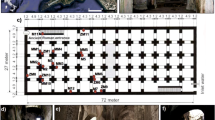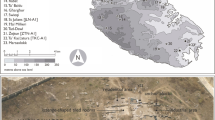Abstract
The archaeometric study of ancient mortars can provide important information relating to the raw materials used and their provenance. A mineralogical and petrographic study based on optical and electron microscopy on mortars from the Roman Theatre of Aosta (NW Italy) was carried out. The construction of the theatre is believed to have taken place a few decades after the foundation of Augusta Praetoria, the ancient city of Aosta, in 25 BC. Both original and mortars belonging to four different subsequent restoration interventions were studied. It was possible to detect the areas of origin of the materials used for the historical mortars, which were of local provenance, being characterized by abundant metamorphic minerals, typical of Alpine orogeny. X-ray element maps were also created to better define the distribution of aggregate, binder and porosity. The characterization of the binder was obtained by creating two-dimensional maps of the hydraulic index. These made it possible to distinguish aerial mortar from the Roman age samples and hydraulic mortars for subsequent restorations.












Similar content being viewed by others
References
Appolonia L, Vaudan D, Glarey A (2010) Lo studio delle malte del Teatro romano di Aosta: una ricerca in corso. Regione Autonoma della Valle d’Aosta, Bollettino della Soprintendenza 6:249–252
Bakolas A, Biscontin G, Moropoulou A, Zendri E (1995) Characterization of the lumps in the mortars of historic masonry. Thermochim Acta 269:809–816
Bany YIA, Al-Amoush H, Al-Farajat M, Mayyas A (2013) Petrography and mineralogy of Roman mortars from buildings of the ancient city of Jerash, Jordan. Constr Build Mater 38:465–471
Belfiore CM, Fichera GV, Ortolano G, Pezzino A, Visalli R, Zappalà L (2016) Image processing of the pozzolanic reactions in Roman mortars via X-ray map Analyser. Microchem J 125:242–253
Belfiore CM, Visalli R, Ortolano G, Barone G, Mazzoleni P (2022) A GIS-based image processing approach to investigate the hydraulic behavior of mortars induced by volcanic aggregates. Constr Build Mater 342:128063
Beltrando M, Compagnoni R, Lombardo B (2010) (ultra-) high-pressure metamorphism and orogenesis: an alpine perspective. Gondwana Res 18:147–166
Boynton RS (1980) Chemistry and technology of lime and limestone, 2nd ed. JohnWiley & Sons, New York
Bruni S, Cariati F, Fermo P, Cairati P, Alessandrini G, Toniolo L (1997) White lumps in fifth-to seventeenth-century ad mortars from northern Italy. Archaeometry 39:1–7
Cannic S, Lardeaux JM, Mugnier JL, Hernandez J (1996) Tectonometamorphic evolution of the Roignais-Versoyen unit (Valaisan domain, France). Eclogae Geol Helv 89:321–343
Cantù M, Giacometti F, Landi AG, Riccardi MP, Tarantino SC, Grimoldi A (2015) Characterization of XVIIIth century earthen mortars from Cremona (northern Italy): insights on a manufacturing tradition. Mater Charact 103:81–89
Dal Piaz GV (1999) The Austroalpine-Piedmont nappe stack and the puzzle of Alpine Tethys, in Gosso G et al. (eds) Third Meeting on Alpine Geological Studies. Memorie di Scienze Geologiche, 51: 155-176.
De Giusti F, Dal Piaz GV, Massironi M, Schiavo A (2004) Carta geotettonica della Valle d’Aosta. Mem Sci Geol 55:129–149
Derrik MR, Stulik D, Landry JM (1999) Infrared spectroscopy in conservation science. The Getty Conservation Institute, Los Angeles CA.
Elsen J (2006) Microscopy of historic mortars—a review. Cem Concr Res 36:1416–1424
Elter G, Elter P (1965) Carta geologica della regione del piccolo S. Bernardo (versante italiano): note illustrative. Memorie Istituto Geologico Mineralogico Università di Padova 25:1–53
Ernst W, Dal Piaz G (1978) Mineral parageneses of eclogitic rocks and related mafic schists of the Piemonte ophiolite nappe, Breuil-St. Jacques area. Italian Western Alps American Mineralogist 63:621–640
Guidotti CV (1984) Micas, reviews in mineralogy. Mineralogical Society of America, Chelsea
Hey MH (1954) A new review of chlorites. Mineral Mag 30:277–292
Hughes JJ, Leslie AB, Callebaut K (2001) The petrography of lime inclusions in historic lime based mortars. Proceedings of the 8th Euroseminar on Microscopy Applied to Building Materials, pp 359–364
Karkanas P (2007) Identification of lime plaster in prehistory using petrographic methods: a review and reconsideration of the data on the basis of experimental and case studies. Geoarchaeology 22:775–796
Lezzerini M, Ramacciotti M, Cantini F, Fatighenti B, Antonelli F, Pecchioni E, Fratini F, Cantisani E, Giamello M (2017) Archaeometric study of natural hydraulic mortars: the case of the late Roman villa dell’Oratorio (Florence, Italy). Archaeol Anthropol Sci 9:603–615
Lezzerini M, Raneri S, Pagnotta S, Columbu S, Gallello G (2018) Archaeometric study of mortars from the Pisa’s Cathedral Square (Italy). Measurement 126:322–331
Loprieno A, Bousquet R, Bucher S, Ceriani S, Dalla Torre FH, Fugenschuh B, Schmid SM (2011) The Valais units in Savoy (France): a key area for understanding the palaeogeography and the tectonic evolution of the Western Alps. Int J Earth Sci 100:963–992
Lindqvist JE, Sandström M (2000) Quantitative analysis of historical mortars using optical microscopy. Mat Struct/Matériaux et Constructions 33:612–617
Manzotti P, Ballèvre M, Zucali M, Robyr M, Engi M (2014) The tectonometamorphic evolution of the Sesia-dent Blanche nappes (internal Western Alps): review and synthesis. Swiss J Geosci 107:309–336
Malusà MG, Polino, Martin S (2005) The gran San Bernardo nappe in the Aosta valley (western Alps): a composite stack of distinct continental crust units. Bulletin de la Société Géologique de France 176:417–431
Mariani E (1976) I leganti aerei e idraulici. Casa Ed. Ambrosiana Milano
Miriello D, Barca D, Bloise A, Ciarallo A, Crisci GM, De Rose T, Gattuso C, Gazineo F, La Russa MF (2010) Characterisation of archaeological mortars from Pompeii (Campania, Italy) and identification of construction phases by compositional data analysis. J Archaeol Sci 37:2207–2223
Morimoto N (1988) Nomenclature of pyroxenes. Mineral Petrol 73:1123–1133
Moropoulou A, Theoulakis P, Chrysophakis T (1995) Correlation between stone weathering and environmental factors in marine atmosphere. Atmospheric Env 29:895–903
NORMA UNI 10924 (2001) Malte per elementi costruttivi e decorativi: classificazione e terminologia. Ed UNI (Ente Nazionale Italiano Unificazione) Milano
NORMA UNI EN 13925-1 (2006a) Prove non distruttive – Diffrazione a raggi X dai materiali policristallini e amorfi – Parte 1: Principi generali. Ed. UNI (Ente Nazionale Italiano Unificazione) Milano
NORMA UNI EN 13925-1 (2006b) Prove non distruttive – Diffrazione a raggi X dai materiali policristallini e amorfi – Parte 2: Principi generali. Ed. UNI (Ente Nazionale Italiano Unificazione) Milano
NORMA UNI EN 13925-1 (2006c) Prove non distruttive – Diffrazione a raggi X dai materiali policristallini e amorfi – Parte 3: Principi generali. Ed. UNI (Ente Nazionale Italiano Unificazione) Milano
Papayianni I, Stefanidou M (2001) The evolution of porosity in lime-based mortars. Proceed 8th Euroseminar Microsc Appl Build Mat:451–457
Pecchioni E, Fratini F, Cantisani E (2018) Le malte antiche e moderne tra tradizione ed innovazione. Pàtron Editore, Seconda Edizione, Bologna
Pedelì C (2009) L'Area del teatro romano di Aosta: le attuali condizioni e le prime misure conservative. Bollettino della Regione Autonoma Valle d’Aosta 6:242–248
Petrakakis K, Dietrich H (1985) MINSORT: a program for the processing and archivation of microprobe analyses of silicate and oxide minerals. Neues Jahrb Mineral Monatshefte 8:379–384
Pires J, Cruz AJ (2007) Techniques of thermal analysis applied to the study of cultural heritage. J Therm Anal Calorim 87:411–415
Riccardi MP, Lezzerini M, Carò F, Franzini M, Messiga B (2007) Microtextural and microchemical studies of hydraulic ancient mortars: two analytical approaches to understand pre-industrial technology process. J Cult Heritage 8:350–360
Schiele E, Berens LW (1976) La Calce. Calcare, calce viva, idrato di calce. Ed. Tecniche ET Milano
Von Raumer JF (1987) Les massifs du Mont Blanc et des aiguille rouges: temoins de la deformation de croute varisique dans les Alpes occidentales. Geologie Alpine 63:7–24
Whitney DL, Evans BW (2010) Abbreviations for names of rock-forming minerals. Am Mineral 96:185–187
Funding
The research was supported by the University of Torino (ex 60% funds). It was carried out in the frame of GeoDIVE Project (M. Giardino coord.), funded by Compagnia di San Paolo Foundation and University of Torino.
Author information
Authors and Affiliations
Corresponding author
Ethics declarations
Competing interests
The authors declare no competing interests.
Additional information
Publisher’s note
Springer Nature remains neutral with regard to jurisdictional claims in published maps and institutional affiliations.
Rights and permissions
Springer Nature or its licensor holds exclusive rights to this article under a publishing agreement with the author(s) or other rightsholder(s); author self-archiving of the accepted manuscript version of this article is solely governed by the terms of such publishing agreement and applicable law.
About this article
Cite this article
Gambino, F., Glarey, A., Cossio, R. et al. SEM-EDS characterization of historic mortar as a tool in archaeometric study: an updated analytical protocol tested on the Roman theatre of Aosta (NW Italy). Archaeol Anthropol Sci 14, 179 (2022). https://doi.org/10.1007/s12520-022-01645-9
Received:
Accepted:
Published:
DOI: https://doi.org/10.1007/s12520-022-01645-9




